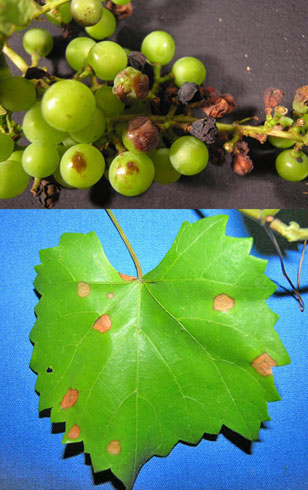Arkansas Plant Health Clinic Disease Notes
Contact
Plant Diagnostician
Phone: (479) 575-2727
Email: ssmith@uada.edu
Jason Pavel
Diagnostician
Phone: (479) 575-7257
Email: jpavel@uada.edu
Office:
University of Arkansas System Division of Agriculture
Cralley Warren Building
Room 16
2601 N. Young Ave.
Fayetteville, AR 72704
Grape Black Rot
Plant Health Clinic Disease Note Issue 22
Sherrie Smith and Jason Pavel
Grapes are not an easy crop to grow in Arkansas. Our high humidity and warm weather are favorable for fungal diseases.

(Photos by Sherrie Smith, University of Arkansas System Division of Agriculture Cooperative Extension Service)
Black Rot, caused by the fungus Phyllosticta ampelicida, formerly Guiganardia bidwellii, is the most economically important disease of grapes. All new growth is susceptible throughout the growing season, including leaf laminates, petioles, shoots, tendrils, peduncles, and fruit.
What are the symptoms of grape black rot?
Symptoms on leaves are circular tan spots that eventually become reddish brown with a narrow dark brown border.
Black pimple-like fruiting bodies of the fungus form in the lesions. The fruiting bodies also appear in black lesions on the young shoots. Infection on the berries starts as a small white dot. In only a few hours, the tiny dot is surrounded by a reddish-brown ring. Within a few days the berry starts to dry, shrivel, and wrinkle to become a hard, blue- black mummy.
The symptoms on Muscadine fruit are small, black, superficial, scabby lesions on infected berries. The lesions may coalesce to cover most of the berries. Infected berries may crack at the edges of the scabs.
How can I control grape black rot?
Black Rot can be effectively controlled by using Captain, or Abound, or Pristine, or Aprovia, or Revus Top, or Adament, or Topguard, or Inspire Super, or Quadris Top, starting when shoots are 4-6 inches high, and continuing at 14-day intervals until August.
Take Aways:
- Begin fungicides when shoots are 4-6 inches high.
- Continue fungicides on 14-day intervals until August.
Download our grape black rot publication for more info.
Follow us on Facebook!
This work is supported by the Crop Protection and Pest Management Program [grant no. 2017-70006- 27279/project accession no. 1013890] from the USDA National Institute of Food and Agriculture.